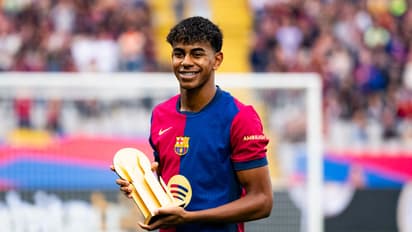Lionel Messi to Lamine Yamal: Decoding the rise, decline and resurgence of Barcelona's iconic La Masia academy
FC Barcelona's La Masia, a youth academy built on a philosophy of skill, teamwork, and possession-based football, has shaped the club's identity and is experiencing a revival with a new generation of promising talents.

La Masia, FC Barcelona’s fabled youth academy, has long been more than a player development hub. Since its foundation in 1979, it has embodied a philosophy, a distinctive playing style, and a broader sporting legacy. Known as the “cradle of Barcelona’s soul,” La Masia has produced players like Lionel Messi, Xavi Hernandez, and Andres Iniesta—players who defined the club’s golden era. However, the academy's influence waned under former president Josep Maria Bartomeu’s transfer-heavy leadership, which sidelined homegrown talent in favour of costly star signings. Now, with a renewed focus on its academy under managers like Xavi Hernandez and Hansi Flick, Barcelona is witnessing a resurgence of La Masia’s influence, pointing to a bright future built on its core values.
The concept of La Masia was born in 1979 under the visionary leadership of then-president Josep Lluís Nunez. He repurposed a small farmhouse near Camp Nou into an academy that would train young footballers not only in skill but in the values of teamwork and intelligence on the field. Inspired by Ajax’s youth system, La Masia focused on developing a playing style that prized ball possession, quick passing, and a “tiki-taka” philosophy.
The academy’s impact on Barcelona’s identity was undeniable, shaping a possession-based style that prioritized collective skill over individual talent. By nurturing young players in this distinctive playing style, La Masia created not only athletes but ambassadors of Barcelona’s philosophy, ensuring a seamless transition to the first team. Over the years, players like Guilhermo Amor, Pep Guardiola, and later, Messi, Iniesta, and Xavi, emerged as legends from the academy.
In 2008, former La Masia player Pep Guardiola took over as head coach, marking a new golden era for the club. With graduates like Messi, Xavi, Iniesta, Gerard Piqué, and Sergio Busquets forming the core of his team, Guardiola’s squad achieved unprecedented success. The “tiki-taka” style reached its pinnacle, and La Masia’s influence was undeniable: in 2010, three La Masia graduates—Messi, Iniesta, and Xavi—were the top three finalists for the Ballon d’Or, a historic achievement no other academy has replicated.
Guardiola’s Barcelona wasn’t just about winning; it was about winning with players who embodied the club’s identity. The era brought the club global recognition and admiration, with La Masia graduates seamlessly executing a philosophy they had internalized since childhood.
With Josep Maria Bartomeu’s presidency starting in 2014, Barcelona’s reliance on La Masia talent declined. Bartomeu pursued high-profile signings, often paying exorbitant fees for stars like Philippe Coutinho, Ousmane Dembele, and Antoine Griezmann. This transfer-heavy strategy, which collectively cost over 300 million euros, not only strained Barcelona’s finances but disrupted the club’s cultural fabric. Homegrown players struggled to break into the first team, while the “tiki-taka” style began to lose prominence. Financially, Bartomeu’s strategy left the club in deep debt, reducing its flexibility in the transfer market and impacting morale. La Masia graduates were sidelined, leading many young players to seek opportunities elsewhere. La Masia, once central to Barcelona’s identity, found itself adrift as the club shifted its priorities.
Barcelona’s fortunes began to change when Xavi Hernandez, a La Masia graduate himself, took over as head coach. Xavi’s deep understanding of the academy’s importance inspired a return to youth development. Facing financial constraints, he turned to young talents like Gavi, Alejandro Balde, and Pedri. Xavi’s faith in youth was evident in matches such as the Champions League game against Napoli, where he fielded multiple players under 18, showcasing La Masia’s depth and potential.
After Xavi, Hansi Flick, renowned for his youth-focused approach at Bayern Munich, took the reins, continuing to emphasize La Masia’s value. With Flick’s high-pressing tactics aligning well with La Masia’s pass-and-move ethos, young talents like Lamine Yamal, Pau Cubarsi, Marc Casado, and Fermin Lopez began playing prominent roles. Flick’s strategies allowed these players to shine against top-tier teams, establishing themselves as the next generation of La Masia stars.
Several promising players are now emerging from La Masia, rekindling Barcelona’s signature style:
-
Lamine Yamal: A dynamic forward with speed and flair, Yamal has drawn comparisons to Messi for his technical skill and vision. His maturity and playmaking ability have made him a standout talent on the wings.
-
Pau Cubarsi: A composed defender, Cubarsi is known for his tactical awareness and reading of the game. Filling the shoes of veterans, he has become a reliable presence in Barcelona’s backline.
-
Marc Casado: A versatile midfielder, Casado excels in breaking up opposition plays and distributing from deep. His performances against elite teams showcase his readiness for top-flight football.
-
Alejandro Balde: Seen as the successor to Jordi Alba, Balde brings pace and energy to the left flank. His overlap runs and defensive work rate add dynamism to Barcelona’s style.
-
Gavi: Already well-established, Gavi continues to be a central figure. His relentless energy and versatility embody the La Masia spirit, making him a pivotal player in midfield.
-
Fermin Lopez: A versatile attacker, Fermin’s knack for crucial goals and intelligent positioning has bolstered Barcelona’s offense, adding flexibility to the squad.
La Masia’s resurgence extends beyond Barcelona. The academy’s model of youth development, which combines a cohesive playing style with a long-term vision, has become a blueprint for clubs worldwide. As other teams contend with financial pressures, Barcelona’s commitment to homegrown talent offers an inspiring example of sustainable success.
Stay on top of all the latest Sports News, including Cricket News, Football News, WWE News, and updates from Other Sports around the world. Get live scores, match highlights, player stats, and expert analysis of every major tournament. Download the Asianet News Official App from the Android Play Store and iPhone App Store to never miss a sporting moment and stay connected to the action anytime, anywhere.